Nestled in Nogales: Migrants in limbo at US-Mexico border create their own community
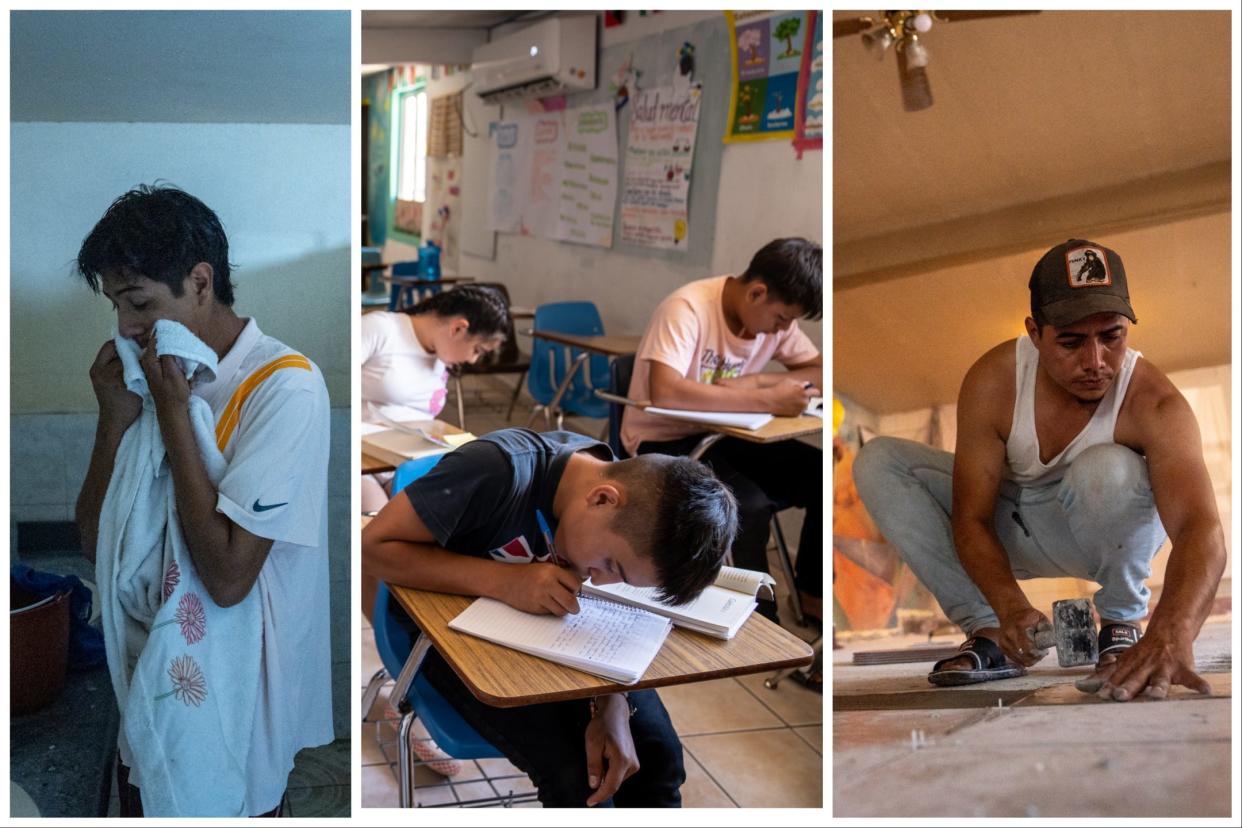
NOGALES, SONORA — María Esmeralda Ramírez Garcia never wanted to leave her home.
She never desired to migrate in search of better fortunes. She never imagined deserting her life in Guatemala for one in the U.S.
She was happy there.
Garcia and her two sons were forced to abandon their home at a moment’s notice. A criminal Colombian gang was on their heels.
Garcia and her sons now found themselves in an increasingly stuffy and cramped kitchen at La Casa de la Misericordia y de Todas las Naciones in Nogales, Sonora. It had been eight months since they fled Guatemala and four since they arrived at the migrant shelter.
Garcia weaved around her children as she darted from the pantry to the stove to the refrigerator. She was in charge of feeding the shelter’s approximately 100 residents in less than an hour.
Growing flames licked a cauldron of refried beans bubbling on the stove. Bouts of laughter often erupted from the handful of women sitting around the kitchen table, prepping the remaining ingredients for dinner.
Bed sheets covering the kitchen’s windows billowed into the dining room as music spilled through. Men could be heard singing and chipping at tile as they laid a new dining room floor.
Garcia's oldest son, Carlos Roberto, smeared globs of white paint onto the kitchen ceiling.
Stray paint streaks embellished his face and arms as Carlos Roberto, best known as “Beto” in the shelter, delicately brushed the ceiling. His 3-year-old brother, José Samuel, crouched beneath him, scraping any rogue droplets from the floor.
A couple of dried drops of paint, which José Samuel hadn’t seen but probably felt, coated the top of his close-cut hair.
Dinner was a family affair.
Dozens of people soon filed into the kitchen, retrieved their plates and enjoyed dinner together outside at wooden picnic tables. The long-term sanctuary, where the family found themselves, more closely resembled a bustling neighborhood rather than a migrant shelter on the Arizona-Mexico border.
The shelter was established at the height of the pandemic in 2020 when the U.S.-Mexico border was closed to arriving asylum seekers under the Title 42 health restriction. Asylum seekers were taken in and given refuge until they were able to request asylum and enter the U.S., a monthslong tenure that for some lasted longer than a year.
The lives of people fleeing danger and seeking a better life intersect in the refuge for days, weeks or months at a time. Dozens of people from around the world find themselves on a similar journey at a waystation with companions brought together by circumstance.
People share in each other's struggles, joys, despair, sadness, humor, bliss and jubilation. Relationships and tensions form and dissipate as day-to-day routines carry on.
Tales of a bygone taxi driver, a jack-of-all-trades and a promise to be kept all endure within the refuge’s walls.
“This house has no life without you,” Shelter Director Alma Angélica Macías Mejía said to the residents. “Life is made by you.”
Asylum seekers coordinate, manage, clean, build, fix and troubleshoot nearly all aspects of the shelter. An outdoor clay oven, vegetable garden and a chicken coop nourish the thriving community.
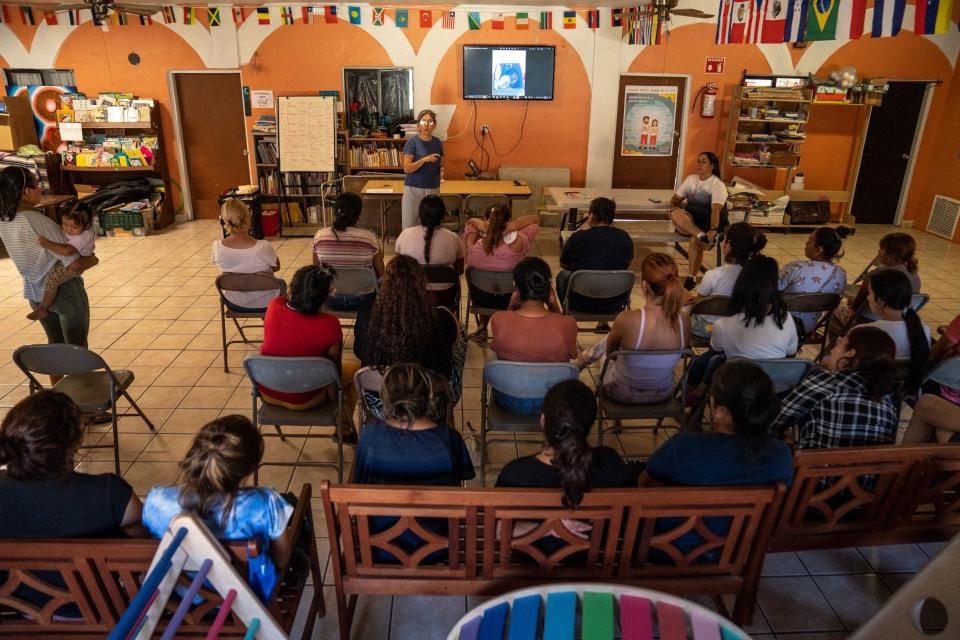
Children attend daily classes while adults learn trade skills ranging from electrical to automotive work. Weddings, quinceañeras, movie nights and cookouts have all been celebrated within the shelter.
Ten people have given birth during their stay, with five babies being born within the refuge.
The shelter is walled off from the rest of the city, protecting its residents from the dangers and discrimination that asylum seekers face in Nogales. Asylum seekers reside in the shelter until they’re able to secure their passage to the U.S. through a port of entry, a process that can take months with the CBP One government mobile application.
The entire shelter buzzes with elation when someone finally secures their coveted CBP One appointment. It’s a moment of celebration for many who have been trying to book an appointment daily for months.
In a few days, Garcia and her family would have their appointment at the port of entry. Despite months of anticipation, trial and error, the family was somber.
They must now depart a place of safety and compassion where they’ve intertwined their lives with dozens of others. They didn’t want to leave.
They were happy there.
“It’s once again experimenting with leaving a house because there is no happiness in leaving this shelter,” Beto said. “It’s not a shelter, it’s a home.”
Beto would soon leave the shelter with a promise to return. A vow to step back inside the sanctuary’s walls years from now, not as a resident, but as an immigration attorney.
He promised to come back. He promised to help those at a refuge he, too, had once called home.
Morning
The shelter is never fully dark nor silent.
The embers of yellow street lamps and wayward headlights enshrine the migrant shelter that’s perched high above the belly of Nogales.
An orchestra of dog barks and rooster crows serenades the community as the early morning darkness envelops the refuge. The shelter’s enclosed buildings and passages are lonely and hushed as its residents savor the final minutes of nighttime tranquility.
The sun begins to rise over the sprawling neighborhoods and winding dirt roads that watch over the shelter. Sunlight floods in and the community abruptly stirs to life.
Dormitory doors swing open as parents emerge with their groggy children, ready to romp on the metal playground outside their door. The handful of scruffy dogs who roam the property shake off the night and stretch in the morning sun.
The shelter has awakened.
A boy with a small metal bell walked through every crevice of the refuge. He strolled in front of each dormitory, down every hallway and on every floor — ringing the tiny bell as loud as he could to announce that breakfast was served.
Garcia, best known as “Doña Mari” among residents, was in the kitchen, masterfully slinging out plates of eggs and tortillas.
She had experience.
Garcia owned three businesses and more than 100 pets, including three peacocks, in Quetzaltenango, Guatemala.
The family ran a restaurant, a coffee bar and a pet shop. Beto was studying to become a lawyer and was on the city’s basketball team.
A Colombian criminal outfit recently had established a presence in their city, intimidating and extorting business owners for money. If someone didn’t pay or put up a fight, they would kill them, Garcia said.
Many people in the city died at the hands of the Colombian gang, including a handful of Beto’s friends, Garcia recalled. Garcia decided to report the organization to the police, giving them full names and numbers of their phones, license plates and bank accounts.
She was thanked for her bravery.
Four hours after filing her police report, the criminals already knew Garcia had reported them.
Garcia hurriedly grabbed her sons and fled. She abandoned her house just as she had left it that morning, leaving behind all of her pets and belongings.
Garcia didn’t even tell her mother or brothers in town that she was leaving. Her mother eventually had to move houses because the gang found out where she lived while two of her brothers were forced to shutter their businesses.
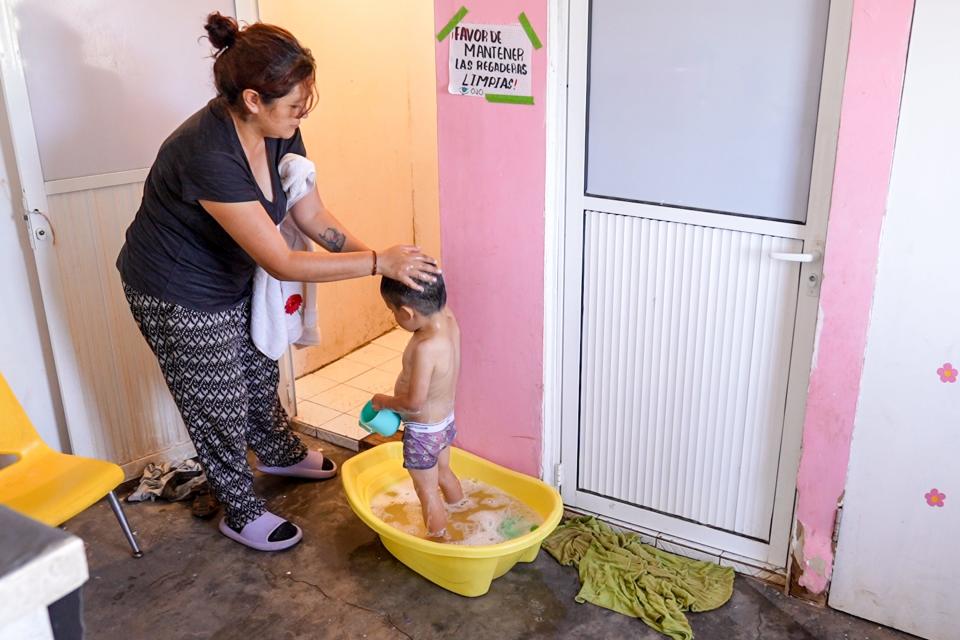
Criminal members even offered neighbors money to give up Garcia’s location.
“I was fine. My mistake was reporting the Colombians,” Garcia said. “It's sad that they take you out of your country.”
Garcia and her family fled to Tapachula, Chiapas, Mexico, where they stayed for two months in the hopes that the criminals would be investigated and subsequently jailed, allowing the family to return home.
During their stay in Mexico, a family friend sold the family to the cartel to be trafficked. The family was kidnapped by the cartel and transported to the desert near Altar, Sonora, where they were told to walk.
The family was taken from houses to warehouses in a series of trailers that each carried roughly 500 people, Garcia said.
The family came across multiple pits at the second-to-last warehouse in Sinaloa. The smugglers threatened to throw them into the ditches if they made noise in the trailer.
José Samuel was drugged when he began to cry during one of the trailer rides, Garcia said. Hundreds of people were stuffed into the trailer where they could go days without food or water.
“I felt that we weren’t going to get out,” Garcia said. “I thought that we were going to die in the trailer.”
After surviving the desert, the family was forced by smugglers to cross the border in between ports of entry twice. They were apprehended by Border Patrol and expelled into Mexico both times until they found their way to the shelter in April.
Afternoon
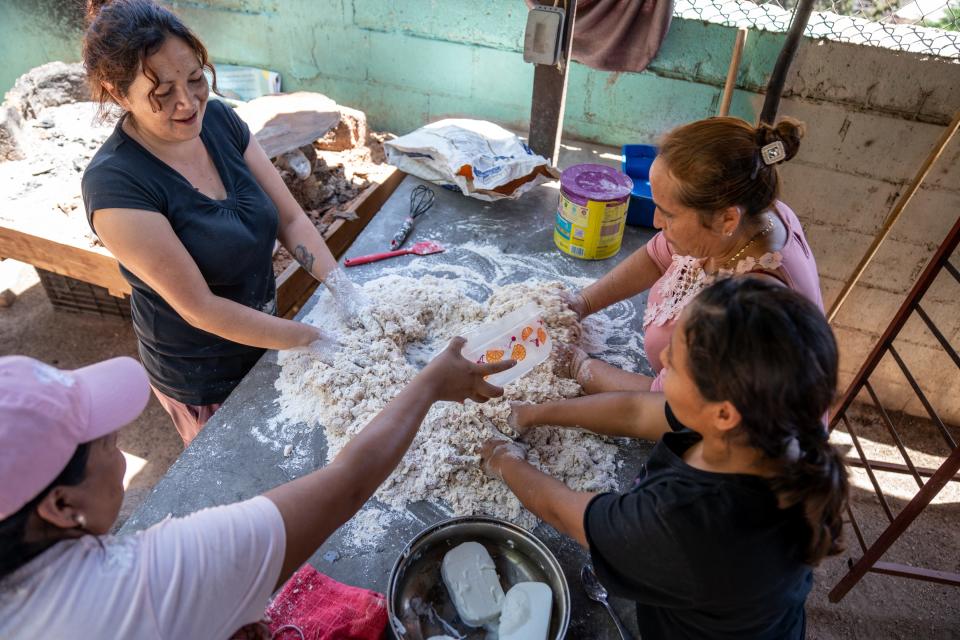
Garcia buried her hands in a mountain of dough.
She slammed the dough lump onto the concrete table as the three women next to her did the same. Their hands occasionally snagged a fistful of lard to massage into the mound, softening the dough.
A hum of conversation rose from the table as the women rolled, folded, slapped, smeared and whacked the dough. A broad clay oven with a scorched black mouth stood behind them, spewing out blistering fumes.
It was Saturday afternoon and they were baking bread, a longstanding weekly tradition in the shelter. It’s a time for residents to gather and bond over the near-universal practice.
“It’s Saturdays' therapy,” Garcia said.
Across the courtyard from the oven, Martin Rivera Hernandez mixed concrete in a plastic bucket as he worked to retile the dining room floor. About an hour later, Hernandez would be giving haircuts to people underneath the garage canopy.
Hernandez, 32, studied oceanology in college before graduating as a civil engineer. He eventually started his own business in Colima, Mexico, after working in numerous trades since he was 13.
Heating, welding, construction, carpentry, air conditioning and cutting hair: Hernandez knows it all.
“Everything that you can imagine that a house needs, from floor to ceiling, Martin knows how to do it,” Hernandez said.
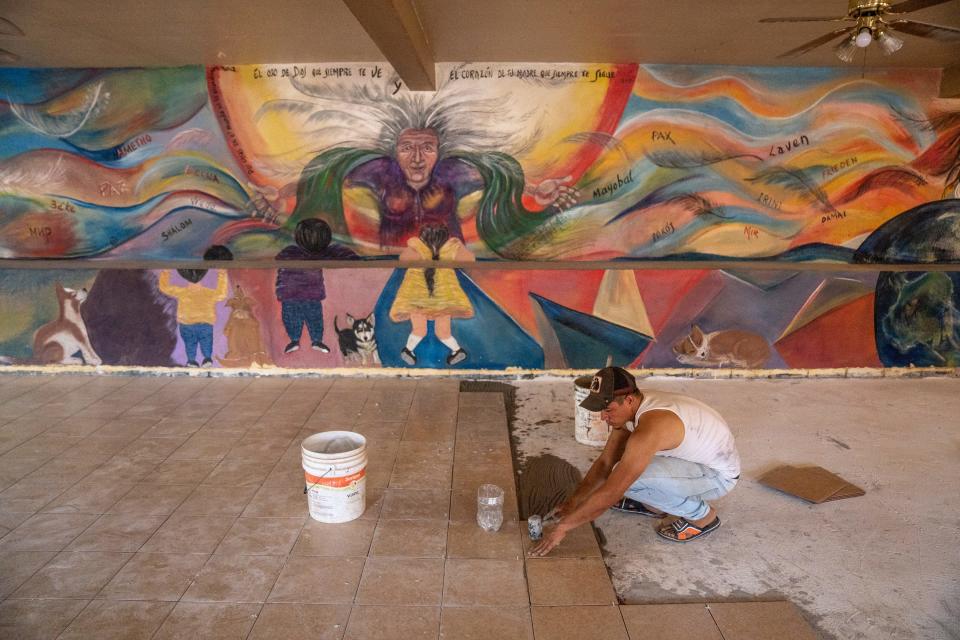
“I never stayed in only one profession, I always looked for a way to learn and move.”
Hernandez was forced to flee his home in Colima after being targeted by organized crime and local and state authorities.
“Once you enter the door here, you feel a relief, you feel you can breathe,” Hernandez said. “It’s a safe space where not the mafia nor the government nor immigration authorities can come and bother you.”
In the nearly five months since he arrived at the refuge, Hernandez has become the shelter’s charismatic and affable jack-of-all-trades.
He could often be seen sitting in the barber’s chair under the garage canopy’s shade where it was rare to find him not talking, laughing, embracing or calling out to someone passing by.
Hernandez had found community in the shelter.
“We all have a common goal: flee. Flee from things that hurt us,” Hernandez said.

As Hernandez spoke, the shelter’s dogs were splayed out in the shade of a van in the dirt parking lot nearby. A cool breeze occasionally broke up the unrelenting sun, which baked the entire shelter.
Parents huddled beneath the shade of the large trees as their children swung on the nearby swing set. The community was quiet as most people stayed inside and away from the blistering sun.
Metal shelves of folded clothes towered over Liliana Rodríguez as she sat at the door of the clothing storage room. Rodríguez was in charge of running the operation as donations came in and were distributed amongst residents.
Rodríguez, a native of Venezuela, was one of the final people expelled from the U.S. during the final days of Title 42 in May. The pandemic-era restriction allowed border officials to rapidly expel migrants arriving at the border.
Rodríguez had become an unofficial leader of the shelter during her three-month stay. It was difficult to find someone who did not know and care for her.
“I’m at home,” Rodríguez said.
Rodríguez was a taxi driver in Venezuela before she decided to migrate because of the deteriorating economic situation in her country. She had to sell her taxi in order to be able to afford the journey.
“I got on a barge, I got on a speedboat, I got on a motorcycle, I was left barefoot, I was left without clothes,” Rodríguez said in regard to her journey.
Rodríguez cried, shouted and leaped when she discovered her CBP One appointment was booked. She could hardly read the screen as her hands trembled with emotion.
In a few days, after a traumatic journey and months of waiting, she was finally expected at the port of entry. The bliss she felt when she booked her appointment had begun to fade as reality set in.
“I don’t want to leave but I have to go,” Rodríguez said.
Night
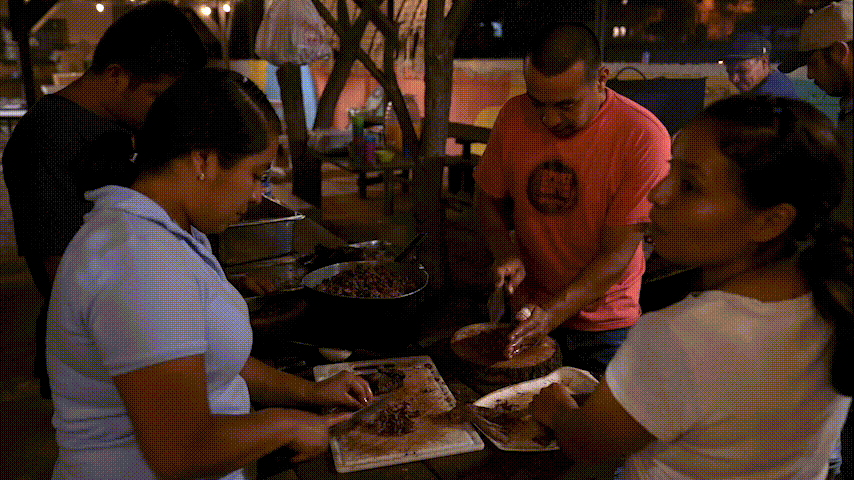
Smoke rose above the shelter and dissipated into the night sky.
Music trickled through a speaker in the shelter’s courtyard as lights gleamed above the residents. Dogs navigated between the bustling picnic tables, browsing for stray pieces of meat.
The shelter was neither dark nor silent.
The cookout was organized as a farewell for the handful of people who would be leaving the community in the coming days. Rodríguez, Hernandez, Garcia and her family would all be leaving soon.
“You don't want to go anymore because you feel part of this place,” Hernandez said to the crowd as they ate dinner. “You make it so yours that in the end you want to stay but you have to keep moving forward.”
“While you all are here, you’re a family.”
Hernandez passed into Arizona the day after his remarks.
As he finished speaking, Hernandez gave the microphone to Beto, Garcia’s 16-year-old son. Garcia and her youngest watched from a nearby table.
“Remember where you come from,” Beto said. “If you can help migrants, help them.”
On one of his last nights in the refuge, Beto was mournful. He would eventually pass into Tucson and reach Houston with his family, leaving the shelter behind.
His former home would remain in Nogales, helping and housing hundreds of asylum seekers who arrived after he left. Beto would continue his life in the U.S.
Years may pass, but the shelter would wait.
Beto had a promise to keep.
Have a news tip or story idea about the border and its communities? Contact the reporter at josecastaneda@arizonarepublic.com or connect with him on X, formerly known as Twitter, @joseicastaneda.
This article originally appeared on Arizona Republic: Migrants waiting on US immigration create community in Nogales

